Heron MJ2+2
by Patrick Harlow
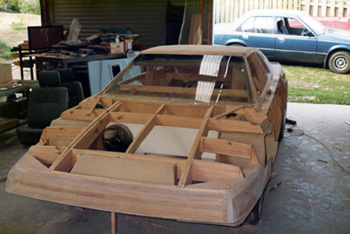
MJ2+2 takes shape in the Baker's shed. 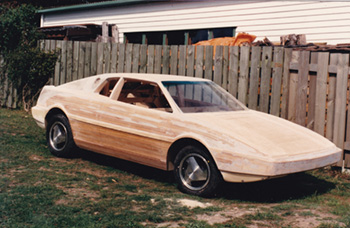
Plug under construction. 
The MJ1 prototype and the MJ2+2 plug together for a photo-op. |
Knowing that the MJ1 would cease production the following year, Christmas of 1984 would be one of the low points of Ross’ working life. Still, Ross is not the sort of person who dwells on his low points. He was always driven by his next project. Ross had already begun work on a car that would supersede the MJ1. His confidence had taken a hit, but his imagination and design flair hadn’t. Work on the MJ 2+2 had started in 1984 as an evening project and was quite cathartic after all the turmoil that had been happening with the MJ1. During that time Ross and Chris Cooke had been, once again, getting together in his workshop at home to work on the plug for what was intended to be a replacement for the MJ1. Like the MJ1 it was inspired by the Lotus Esprit but clearly different to the Lotus and a natural evolution of the MJ1. At the time Ross Baker was the first New Zealand car manufacturer to design a replacement model for a car already in production. The MJ 2+2 shared nothing in common with the MJ1 other than the design premise of having a fibreglass monocoque body. Every dimension was different, and it was an all-round bigger car. The straight edgy lines of the MJ1 had given way to curves. Ross chose the Mitsubishi Cordia windscreen as it had a deeper rake than the Escort windscreen used on the MJ1. Being a taller piece of glass, not only was he able to raise the height of the roof but he reduced the mailbox like effect that had been a criticism of the earlier MJ1. |
|
By the mid to late eighties, front-wheel-drive cars were quickly becoming more popular than rear-wheel-drive cars to the extent that less than a decade later, there were very few rear-wheel-drive cars still in production. Ross realised that front-wheel-drive cars carried almost the entire drivetrain on the front subframe. It would not be difficult to take this entire subframe, remove the steering and fix the front wheels so that they would not steer, and then move it to the back of the car. It would be very easy to take a front-engine front-wheel-drive car and transplant the engine/gearbox/ front running gear into a mid-engined rear-wheel-drive car. The engines were situated in an east-west configuration which took up less room than the north-south configuration of traditional cars. The hardest choice was which donor car to use, it had to be reasonably common, cheap, reliable and easy to upgrade with go faster bits. The Japanese Mazda 626/Ford Telstar ticked all the boxes. To keep the MJ 2+2 modern the interior was designed to take the entire 626/Telstar dashboard. Not only did this save on costs and development, but it also made it sensible to use the donor cars’ wiring loom, thus ensuring that everything would match to the instrument cluster, engine and gearbox, effectively solving most of the headaches they had with the MJ1. The sports and luxury versions of 626 Ltd/Telstar Ghia had a full sports binnacle that was different from anything else on the market at the time and would suit the MJ 2+2’s supercar styling superbly. As with all these things, there was plenty of enthusiasm at the start and the plug took shape quite quickly. It was a lot more complex to build due to having a lot more curves than the MJ1. Rather than flat sheets of plywood, the curves were made up of 30mm x 10mm strips of wood that were shaved to fit. The final shape was once again the result of a lot of finishing using bog and elbow grease. However with no investors on the horizon the finished plug was pushd to the back of the shed during 1986, while Ross concetrated on projects that paid the bills. In the early Ross was visited by Roy Hoare. Roy was keen to build a Heron MJ1.That all changed when Roy said, “although the MJ1 is very nice, I have just decided that I want to build that one over there.” He was pointing to the bogged up plug of the MJ2+2. Roy agreed to fund the expense of getting the moulds made and took ownership of the first body. That was the last Ross saw of the car until he was crossing a road in Rotorua years later in 1999. He heard his name called and discovered it was Roy Hoare. Much to the astonishment of Ross, Roy told him that the car was finished and he had just driven up from Lower Hutt. When he saw it he was impressed, the car looked as good, if not better than any of the Herons that had come out of the Summit factory. Roy took Ross for a ride in the now Mitsubishi V6 powered MJ2+2. Only two MJ2+2s were pulled out of the moulds and the moulds are now in the possession of Alan Whichman who has restored them. Alan is also the current owner of the second car and maybe one day it too will see light of day. |
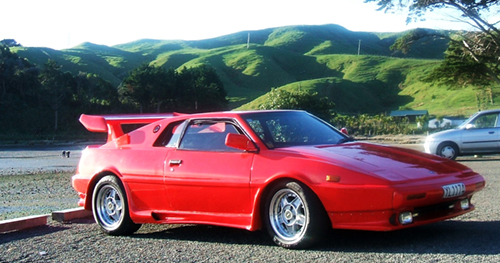
Roy's finished car. 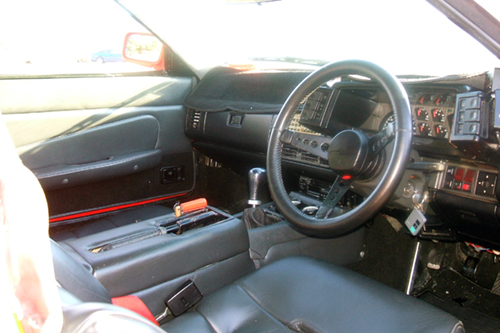
The Telstar Ghia dashboard gives it a supercar interior. 
|
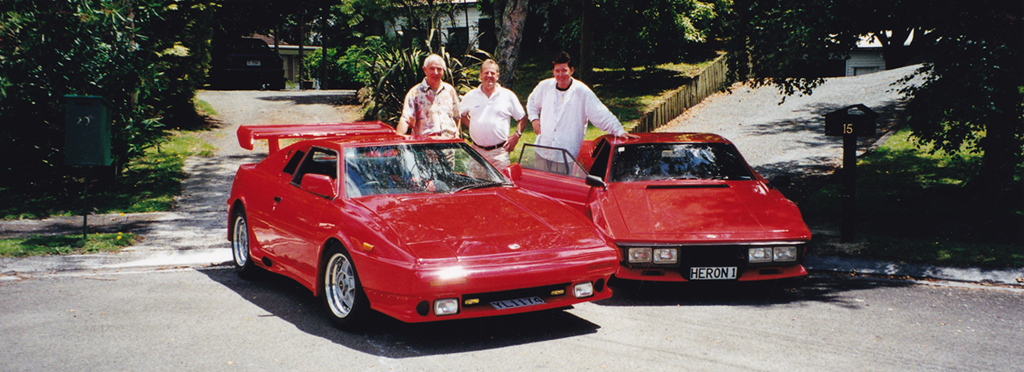
The Heron MJ2+2 and the Heron MJ1. At the back from the left is Roy Hoare, Ross Baker and Cleigh Hartley.









